Hair Structure Explained
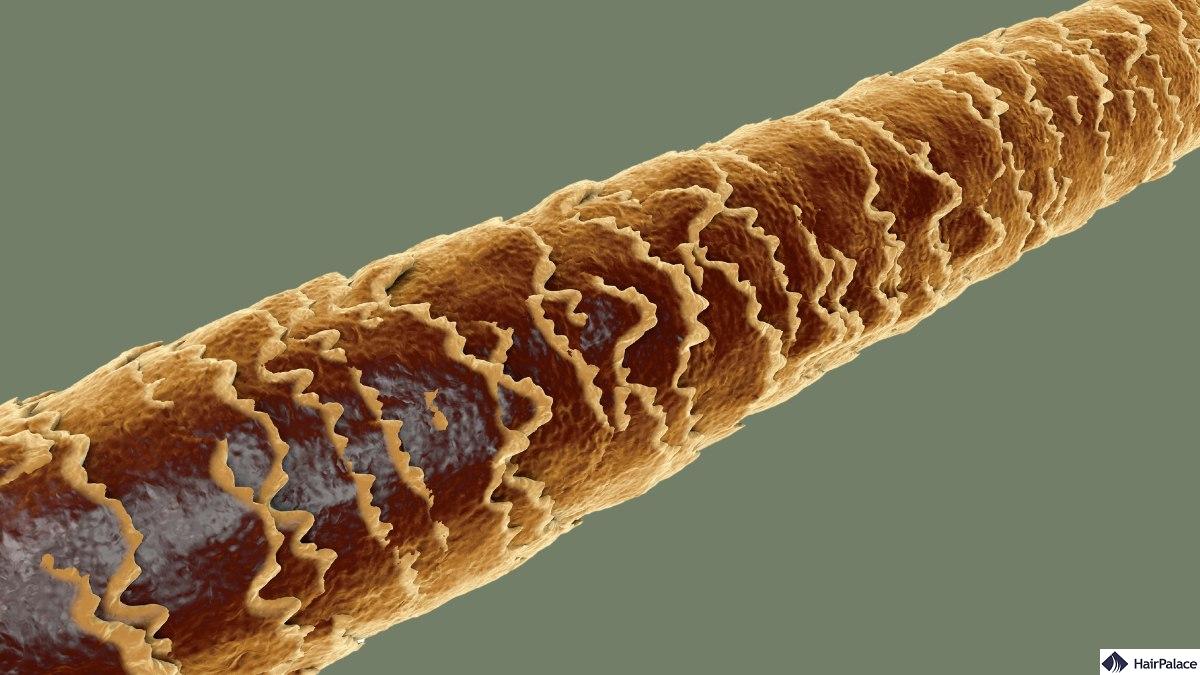
One of the key ways of supporting your hair, stimulating new growth, and preventing further hair loss is understanding its structure, how it is made, and what its functions are.
Don’t worry – you don’t need to be a scientist to get to grips with everything your hair does.
We’re here to help you understand the internal structure of hair.
This article will explore everything you need to know about hair structure.
We’ll take you on a step-by-step journey of how it’s formed, the different stages of how it grows, and highlight ways you can support your hair all the while.
- Different hair types
- The structure of hair
- Hair bulb
- Roots and follicles
- Hair shaft
- What is hair made out of?
- How does hair grow?
Different types of hair
There are two different hair structures found on the body.
Firstly there’s short, thin hair known as vellus hair.
They are more commonly known as body hair.
It helps regulate your body temperature and also protects your skin.
The second type is known as terminal hairs, which is found on your scalp, facial hair, eyebrows, eyelashes, and pubic regions.
It functions similarly to vellus hair, except it is much longer and thicker.
Factors that influence how much vellus or terminal hair you have includes your age and sex.
Women, on average, have 30% of their bodies covered in terminal hair, compared to 90% of men.
Hair structure diagram
Every strand has both a shaft and root; each one plays a pivotal role in the appearance and function of your hair.
The shaft is the visible part we all recognize as hair, which extends beyond the outer layer of the skin.
The hair root is located in the deeper layers of the skin.
A small muscle known as the arrector pili is connected to the root and is incredibly sensitive to temperature.
It is responsible for standing hair up to regulate heat.
The root is surrounded by the hair follicle, which provides protection and nourishment as the hair fiber develops.
There are also glands, including the sebaceous gland, responsible for producing sebum.
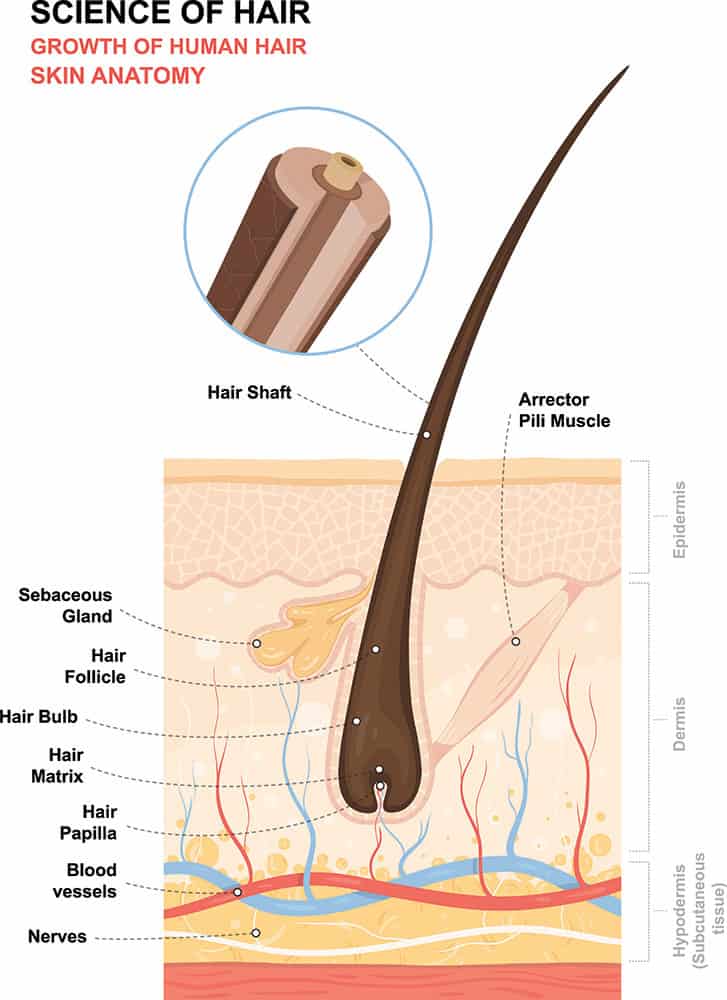
Structure of hair bulb
Think of the bulb of hair as the power cell inside your hair follicle, which is needed for your hair to grow.
As the root widens towards the bottom of the follicle, it forms a hair bulb.
The bulb also contains several other muscles and components, including the hair papilla, hair matrix and both the inner root sheath and outer root sheath.
During the start of the hair growth cycle, living cells divide over and over inside the bulb, helping to create brand-new hair.
The nearby hair papilla supplies all the nourishment, oxygen, and more needed to sustain this growth.
As the hair moves into the second growth phase, cells push upwards, gradually hardening.
Eventually, they will reach the end of the root sheath and form concentric layers; the hair; the cuticle, the cortex, and the medulla.
Finally, the hair bulb and hair matrix are the sources of melanocytes, cells that contain the pigment responsible for your hair color.
It also has specialized stem cells known as mesenchymal cells, essential ingredients for new growth and repair.
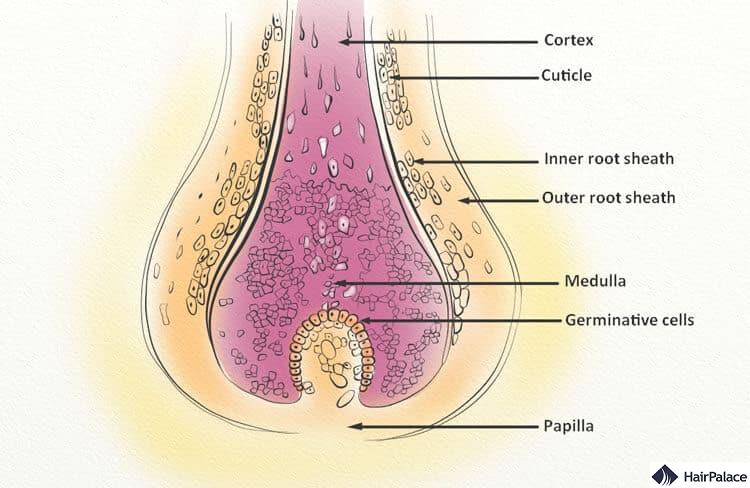
Root hair cell structure and hair follicle structure
Every hair on your head grows from the skin’s surface, known as the epidermis.
Two core components form the hair as we know it; the hair root and the hair follicles.
The hair follicle is found underneath the skin’s surface. It is essentially connective tissue that helps to grow new hair fibers.
The hair bulb is here, which enables the hair to receive nourishment from the bloodstream.
The bulb comprises special stem cells that form together to make the hair shaft, including melanocytes which decide your hair colour.
The shape of the hair follicle determines the texture of your hair – round follicles create straight hair, while oval-shaped follicles create curly, wavy hair.
Additionally, hair follicles have a sebaceous gland, which helps produce sebum, otherwise known as oil.
Sebum moisturizes your scalp and hair and prevents dehydration.
That said, an overactive gland can cause greasy hair and skin.
The follicle surrounds the hair root, located just above the bulb.
The root is responsible for supporting your hair to grow beyond the follicle.
What are hair shafts?
The hair shaft is the part of the hair that is visible above the skin’s surface.
It is primarily made up of a protein named keratin, which, when compacted together, becomes incredibly firm and durable.
Keratin is the protein that produces strong nails and feathers, hoofs, and claws in animals.
It is firm, durable, and resistant to damage – making it the perfect building block for hair.
The hair shaft consists of three parts. They are:
- Cuticle
- Cortex
- Medulla
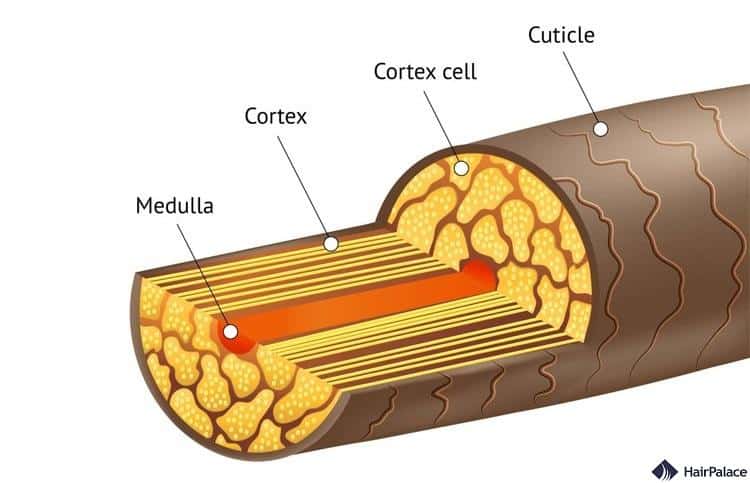
1. Cuticle
The cuticle is the outer layer of the hair shaft.
Like roof tiles, it comprises overlapping cells that bolster together to form a layer of protection for the rest of the hair shaft.
The cuticle is transparent and is responsible for giving your hair a signature shin.
When healthy, the cuticle will be smooth to the touch.
The cuticle also maintains optimal moisture levels across your entire hair.
That said, harsh chemicals and weather can disrupt the cuticle and compromise its ability to protect your hair.
This, in turn, can lead to hair drying out and becoming brittle.
2. Cortex
As the middle layer, the cortex gives your hair its appearance, texture, and elasticity.
This is where you’ll find melanin, the pigment which gives your hair its color.
Hair becomes grey when a lack of melanin is produced in the hair shaft.
Two types of melanin are found in the cortex – eumelanin, and pheomelanin.
Eumelanin creates dark coloring in hair and is responsible for absorbing UV photos.
On the other hand, pheomelanin is responsible for red, blonde, and auburn hair color.
3. Medulla
The medulla is found in the innermost part of thick, coarse hair.
It contains amino acids like citrulline and sugars like glycogen.
Scientists are still investigating if the medulla has any core purpose.
In animals, it has been suggested it helps control and regulate body temperature.
What is hair made out of?
Now that we’ve discovered what parts make up hair, let’s move on to its chemical compounds.
Knowing how hair is made up can provide vital insight into supporting its growth.
Hair comprises of keratin, a strong and resilient protein bound together with other amino acids in a tight chain. It is also found in your skin and nails.
Increasing your protein intake can give your hair the resources it needs to grow healthy and strong.
Foods like eggs, poultry, meat, nuts, berries, and spinach are all protein-rich.
Other minerals and nutrients that can help your hair include iron, zinc, and vitamins C, D, E, and B12.
How does hair grow?
Because new cells are constantly dividing inside the hair bulb, hair is continuously forming.
As these cells band together, they form a developing strand that takes a long time to reach its growth potential.
Slowly the hair strand is pushed out of the hair follicle at a rate of 1cm per month.
Eventually, the hair will protrude outside the skin surface.
So long as the hair bulb continues to house dividing cells, your hair cycle will continue relatively on track and continue to produce hair.
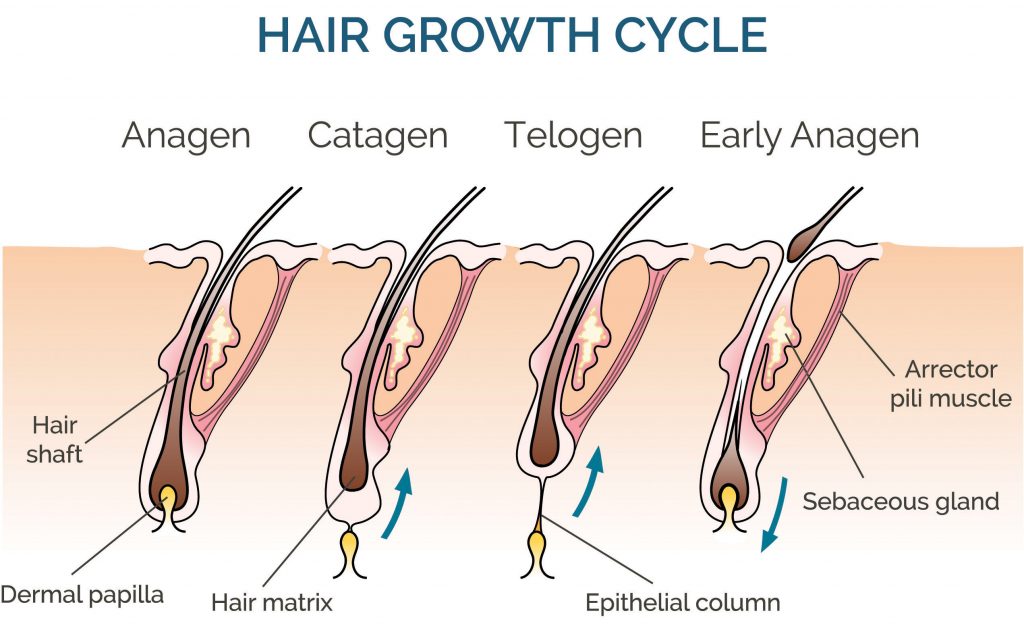
The four stages of the growth cycle include:
- Anagen phase: This growth phase sees cells in the root of the hair rapidly divide. New hair forms and pushes previous club hair out. About 90% of your hair will be in the Anagen phase, which can last several years.
- Catagen phase: This is a transitional phase that signals the end of active growth for the hair and can last between two to four weeks. About 3% of hair is currently in this phase.
- Telogen phase: After the hair completely separates from the papilla, it will enter a resting phase. This can last for several months.
- Exogen phase: This shedding phase is when your hair falls out. You may experience up to 100 strands of hair loss daily. After this stage, the growth cycle starts again, and new hair begins to develop.
Learn more about your hair
With so many stages, chemicals, and processes involved, hair is easily one of the most fascinating parts of the body.
Several factors can influence your hair’s condition, texture, and volume.
You’re undoubtedly interested in finding ways to support each strand and help them reach their potential.
But as well as helping to ensure your hair grows, there are also signs and symptoms of hair loss conditions you must be aware of.
Below is a list of further information that can help explain everything you need to know:
- Hair types
- Hair growth cycle
- Causes of hair loss
- Hair follicle
- Hairline types
- How much hair loss is normal
Hair Structure FAQ
Humidity affects the structure of your hair by introducing moisture to the hair. High humidity can cause hair to swell, disrupt the cuticle layer, and lead to frizz. For curly or wavy hair, this can enhance the curl pattern, while for straight hair, it can lead to unwanted waves or frizz. Conversely, low humidity can make hair dry and brittle.
Permanent hair colour opens the cuticle layer to allow the colour molecules to penetrate the hair shaft. This chemical alteration can weaken the hair, leading to potential damage, dryness, and brittleness over time.
It refers to the arrangement and condition of the cuticle, cortex, and medulla layers that make up individual hair strands, as well as the natural shape and pattern of hair (e.g., straight, wavy, curly). It influences hair’s strength, texture, and appearance.
Yes, it can change due to factors like hormonal shifts, ageing, health conditions, and external treatments such as heat styling, chemical processes, and environmental exposures.
No, once a hair bulb is damaged or destroyed, it cannot regenerate. However, the hair follicle can potentially produce a new hair bulb, unless the follicle itself is permanently damaged.
Both hot and cold water affect how our hair grows positively and negatively.
Hot Water: The benefit of hot water is it easily cleans hair of dirt, debris, and grime. It can also encourage better circulation in your scalp, ensuring follicles receive plenty of oxygen and nutrients. That said, hot water can also rob body hair of natural oils called sebum, which helps keep our hair hydrated.
Cold Water: Cold water helps preserve the hair’s natural oil while ridding your scalp of dirt, grime, and other hazardous debris. That said, cold water can shrivel skin and close hair cuticles up, reducing the volume of your hair.
The main structures of the hair follicle are the dermal papilla, hair bulb, sebaceous gland, arrector pili muscle, and the hair shaft which consists of the cuticle, cortex, and sometimes the medulla.
Last medically reviewed on June 10th, 2024
- What is the structure of hair and how does it growhttps://www.ncbi.nlm.nih.gov/books/NBK546248/
- Lippert H. Lehrbuch Anatomie. Munich: Urban und Fischer; 2017.
- Pschyrembel. Klinisches Wörterbuch. Berlin: De Gruyter; 2017.
- Buffoli B, Rinaldi F, Labanca M et al. The human hair: from anatomy to physiology. Int J Dermatol 2014;53: 331–341.


